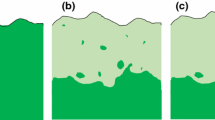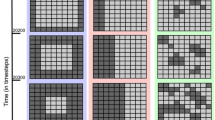Abstract
This paper distinguishes four recognisably different geographical processes in principle causing species to die out. One of these processes, the one we dub “range eclipse”, holds that one range expands at the expense of another one, thereby usurping it. Channell and Lomolino (2000a, Journal of Biogeography 27: 169–179; 2000b, Nature 403: 84–87; see also Lomolino and Channell, 1995, Journal of Mammalogy 76: 335–347) measured the course of this process in terms of the proportion of the total range remaining in its original centre, thereby essentially assuming a homogeneous distribution of animals over the range. However, part of their measure seems mistaken. By giving a general, analytical formulation of eclipsing ranges, we estimate the exact course of this process. Also, our formulation does not partition a range into two spatially equal parts, its core and its edge, but it assumes continuity. For applying this model to data on the time evolution of species, individual time series should be available for each of them. For practical purposes we give an alternative way of plotting and interpreting such time series. Our approach, being more sensitive than Channell and Lomolino’s, gives a less optimistic indication of range eclipses than theirs once these have started.
Similar content being viewed by others
References
Bosch F. van den, J.A.J. Metz, O. Diekmann (1990). The velocity of spatial population expansion. Journal of Mathematical Biology 28: 529–565
Bosch F. van den, R. Hengeveld, J.A.J. Metz (1992). Analysing the velocity of animal range expansion. Journal of Biogeography 19: 135–150
Case T.J., R.D. Holt, M.A. McPeek, T.H. Keitt (2005). The community context of species’ borders: Ecological and evolutionary perspectives. Oikos 108: 28–46
Caughley G., D. Grice, R. Barker, B. Brown (1988). The edge of the range. Journal of Animal Ecology 57: 771–786
Channell R., M.V. Lomolino (2000a). Trajectories to extinction: Spatial dynamics of the contraction of geographical ranges. Journal of Biogeography 27: 169–179
Channell R., M.V. Lomolino (2000b). Dynamic biogeography and conservation of endangered species. Nature 403: 84–87
Donald P.F., J.J.D. Greenwood (2001). Spatial patterns of range contraction in British breeding birds. Ibis 143: 593–601
Fisher D.O., S.P. Blomberg, I.P.F. Owens (2003). Extrinsic versus intrinsic factors in the decline and extinction of Australian marsupials. Proceedings of the Royal Society of London, Series B-Biological Sciences 270: 1801–1808
Haeck J., R. Hengeveld (1981). Changes in the occurrences of Dutch plant species in relation to geographical range. Biological Conservation 19: 189–197
Hengeveld, R. and J. Haeck (1982). The distribution of abundance. I. Measurements. Journal of Biogeography 9: 309–316
Hengeveld R. (1990). Dynamic Biogeography. Cambridge University Press, Cambridge
Hengeveld R., L. Hemerik (2002) Dispersal and biogeography. In: Bullock J.M., R.E. Edward, R.S. Hails (eds.) Dispersal Ecology. Blackwell, Oxford, UK, pp. 303–324
Laliberte A.S., W.J. Ripple (2004). Range contractions of North American carnivores and ungulates. Bioscience 54: 123–138
Lomolino M.V., R. Channell (1995). Splendid isolation: Patterns of geographic range collapse in endangered species. Journal of Mammalogy 76: 335–347
Rodríguez, J.P. (1999). Ecology of the contraction of geographical distributions. PhD Thesis, Princeton University, Princeton, NJ, USA
Rodríguez J.P. (2002). Range contraction in declining North American bird populations. Ecological Applications 12: 238–248
Rodríguez J.P., M. Delibes (2002). Internal structure and patterns of contraction in the geographic range of the Iberian lynx. Ecography 25: 314–328
Sagarin R.D., S.D. Gaines (2002). The ‚abundant centre’ distribution: to what extent is it a biogeographical rule? Ecology Letters 5:137–147
Williams C.K., A.R. Ives, R.D. Applegate (2003). Population dynamics across geographical ranges: Time-series analyses of three small game species. Ecology 84: 2654–2667
Author information
Authors and Affiliations
Corresponding author
Appendix
Appendix
Consider one circular expanding range usurping another range. The easiest way to derive an analytical solution to the problem of the dynamics of this process is to start with a static circular range that overlaps part of another range, either with a straight front (1a), or with a circular one (1b).
1a. Invasion of a circular range by an invader with a straight range front
In Figure 2a, the invaded area Ω is the grey circle segment above the line AC within a circle with centre O and radius r, representing the range limit of the invaded species. We need some definitions for calculating the size of area Ω: as point B lies halfway between A and C, the line OB as a part of a radius is perpendicular to the line AC. The length of the line OB is denoted as |d|, which allows d to be negative. At the time the range limits of the invaded and the expanding species touch, d = r, whereas d is positive as long as the centre of the invaded circle is outside the invaded area. The lines OA and OC are radii of the circle with length r, and the angle α of BOC equals that of BOA. Thus, cos α = d/r and α = arccos(d/r). The area of the circle sector between AO and OC equals r 2α subtracting the area of the triangle AOC from this value, we obtain the formula for Ω (note that in a dynamic approach d is varying in time):
when d lies in the interval [−r, r], this function has a real value, and for values of d outside this interval, the result is complex-valued. Of these, we take the real part, since the invaded area should always be real-valued. The invaded area increases when d goes from r to −r (Figure 5).
A different, possibly helpful parameterisation of the same area, increasing as α changes from 0 to 2π, is \(g(\alpha ,r)\, = \,r^2 \left( {\alpha - \frac{1} {2}\sin (2\alpha )} \right) \).
1b. Calculation of the invaded area for two circular ranges
For two circular ranges, the invaded area Ω in Figure 2b is the part between arc AC of the circle with centre O and arc AC of the circle centred at O′. The circle with centre O′ and radius r′ is assumed to be the expanding area. Let the radius of the upper circle be r′, that is the length of both O′A and O′C, and that of the lower circle r, i.e. the length of OA and OC. The lengths of the line segments OB and O′B are called d and d′ respectively, and the distance between O and O′ is called p. The area of overlap Ω of the two circles can be calculated using the formula derived previously:
The only unknowns are d and d′, which, however, can be calculated from p, r and r′ (from these d, d′, r′ are time dependent). Because OAB and O′AB are both rectangular triangles sharing the line segment AB, we have
Furthermore, we know that
From formulas A3 and A4, we derive A5:
For touching circles, it can easily be shown that d = r and d′ = r′. For overlapping ranges with invaded area Ω, we find
Rights and permissions
About this article
Cite this article
Hemerik, L., Hengeveld, R. & Lippe, E. The Eclipse of Species Ranges. Acta Biotheor 54, 255–266 (2006). https://doi.org/10.1007/s10441-007-9001-1
Received:
Accepted:
Published:
Issue Date:
DOI: https://doi.org/10.1007/s10441-007-9001-1




